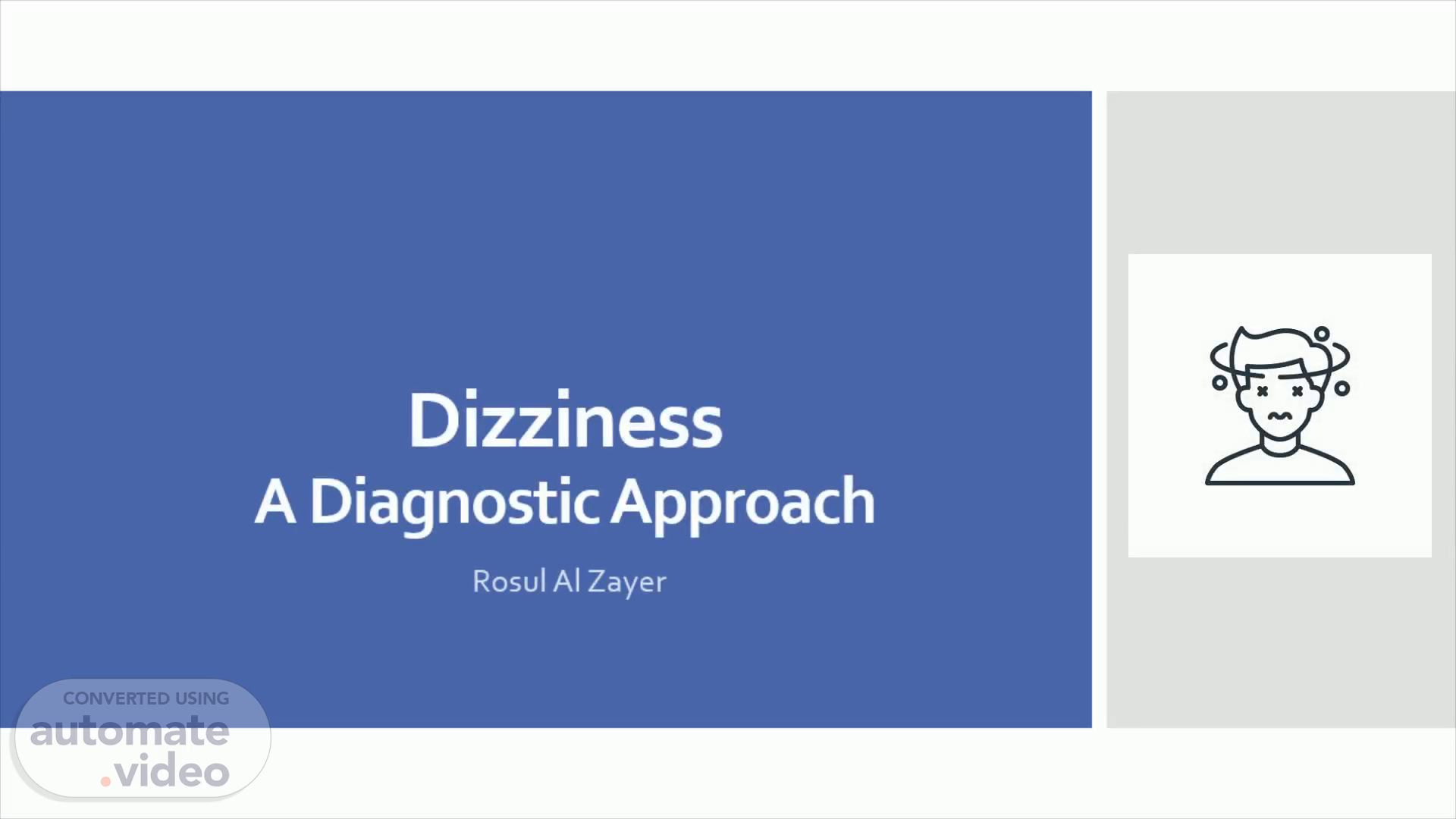
Dizziness A Diagnostic Approach
Scene 1 (0s)
[Audio] DizzinessA Diagnostic Approach. Dizziness A Diagnostic Approach.
Scene 2 (7s)
[Audio] Diagnosing the cause of dizziness can be difficult because symptoms are often non specific and the differential diagnosis is broad. A few simple questions and physical examination tests can help narrow the possible diagnoses. It is estimated that primary care physicians care for more than one half of all patients who present with dizziness. Dizziness is the chief presenting symptom in about 3 percent of primary care visits for patients 25 years and older. Dizziness can be classified into four main types: vertigo, disequilibrium, presyncope, or lightheadedness. Although appropriate history and physical examination usually leads to a diagnosis. However, the final cause of dizziness is not identified in up to one in five patient..
Scene 3 (1m 1s)
[Audio] Patient History The history should first focus on what type of sensation the patient is feeling, include descriptors for the main categories of dizziness. It is important to note that some causes of dizziness can be associated with more than one set of descriptors. A medication history should be obtained because dizziness especially from orthostatic hypotension is a well-known adverse effect of many drugs. Patients should also be asked about caffeine, nicotine, and alcohol intake. Head trauma and whiplash injuries can cause a variety of dizziness symptoms, from vertigo to lightheadedness..
Scene 4 (1m 43s)
[Audio] Vertigo: False sense of motion, possibly spinning sensation Disequilibrium: Off-balance or wobbly. Presyncope: Feeling of losing consciousness or blacking out. Lightheadedness: Vague symptoms, possibly feeling disconnected with the environment. Here is a List of Medications Commonly Associated with Dizziness from Orthostatic Hypotension..
Scene 5 (2m 16s)
[Audio] TiTrATE is a novel diagnostic approach to determining the probable etiology of dizziness or vertigo. The approach uses the Timing of the symptom, the Triggers that provoke the symptom, And a Targeted Examination. The responses place the dizziness into one of three clinical scenarios: Episodic triggered, spontaneous episodic, or continuous vestibular..
Scene 6 (2m 43s)
[Audio] Physical Examination: Blood pressure should be measured while the patient is standing and in the supine position. A full neurologic examination should be performed in patients with orthostatic dizziness but no hypotension or BPPV. The patient's gait should be observed and a Romberg test performed. Patients with an unsteady gait should be assessed for peripheral neuropathy. The use of the HINTS ( head impulse, nystagmus, test of skew) examination can help distinguish a possible stroke (central cause) from acute vestibular syndrome (peripheral cause)..
Scene 7 (3m 24s)
[Audio] Differential Diagnosis of Dizziness and Vertigo: Common Causes Benign paroxysmal positional vertigo: Transient triggered episodes of vertigo caused by dislodged canaliths in the semicircular canals. Vestibular neuritis: Spontaneous episodes of vertigo caused by inflammation of the vestibular nerve or labyrinthine organs, usually from a viral infection. Meniere disease: Spontaneous episodes of vertigo associated with unilateral hearing loss caused by excess endolymphatic fluid pressure in the inner ear. Psychiatric: Initially episodic, then often continuous episodes of dizziness without another cause and associated with psychiatric condition such as anxiety..
Scene 8 (4m 18s)
[Audio] Benign paroxysmal positional vertigo diagnosed with the DixHallpike maneuver..
Scene 9 (4m 47s)
[Audio] Additional Testing: CBC (if you suspect anemia, polycythemia). Fasting and random plasma sugar (if you suspect hyper/ hypoglycemia). ECG (to rule out arrhythmia). Audiometry (to rule in or rule out Menier's disease). Caloric test (to confirm Benign positional vertigo). CT scan or MRI (if you suspect stroke and brain tumors). EEG (if epilepsy is suspected)..
Scene 10 (5m 23s)
[Audio] Patient presents with dizziness Ask about medication regimen; caffeine, nicotine, and alcohol intake; and history of head trauma or whiplash What sensation does the patient describe? False sense of motion or spinning sensation, Vertigo. Ask about migraine symptoms, Hearing loss? And Episodic vertigo? Off-balance or wobbly, Dysequilibrium: Consider possible underlying conditions, such as peripheral neuropathy and Parkinson disease, recheck medication regimen, especially in older patients Examine gait and vision, perform Romberg test, screen for neuropathy. Feeling of losing consciousness or blacking out, Presyncope: Ask about history of arrhythmias and myocardial infarction, recheck medication regimen. Vague symptoms, possibly feeling disconnected with the environment, Lightheadedness: Ask about history of anxiety or depression..
Scene 11 (6m 34s)
[Audio] Treatment: Benign paroxysmal positional vertigo: Meclizine ( Antivert), 25 to 50 mg orally every four to six hours, vestibular rehabilitation. Meniere disease: Salt restriction (less than 1 to 2 g of sodium per day) and/or diuretics (most commonly, hydrochlorothiazide) Intratympanic dexamethasone or gentamicin. Vestibular neuritis: Methylprednisolone, initially 100 mg orally daily then tapered to 10 mg orally daily over three weeks. Migrainous vertigo: Migraine prophylaxis with triptans. Orthostatic hypotension: Review medication regimen. Disequilibrium: Treatment of underlying cause ( peripheral neuropathy, Parkinson disease). Hyperventilation syndrome/ Anxiety: Breathing control exercises, rebreathing into a small paper bag, beta blockers, antianxiety agents (selective serotonin reuptake inhibitors) or short- term use of benzodiazepines..
Scene 12 (7m 52s)
[Audio] Thank you for listening.. Summary. Assessment of Dizziness Episodic Is it triggered or spontaneous? Patient presents with dizziness or vertigo IS the timing episodic or continuous? Cont inuous Is it associated with trauma or toxins. or spontaneous? Triggered • Dix.Hallpike maneuver Spontaneous Migraine headache Vestibular migraine Trauma or toxin Spontaneous HINTS examination Hearing loss Meniere disease Psychiatric symptoms Panic attack. psychiatric condition Barotrauma Positive Benign paroxysmal positional vertigo Negative Assess for Orthostatic hypotension Medications Saccade present, unidirectional horizontal nystagmus, normal test of skew Peripheral etiology Vestibular neuritis No saccade, nystagmus dominantly vertical, torsional Or gaze- evoked bidirectional, abnormal test of skew Central etiologyt Stroke or transient ischemk attack of Symptoms with movement does not aid in determining whether the etiology is peripheral vs. central. t—Central catses can also occur with patterns triggered by movement..
Scene 13 (8m 17s)
References. BMJ Best Practice; Assessment of Dizziness. AAFP; Dizziness: Approach to Evaluation and Management. AAFP; Dizziness: A Diagnostic Approach. UpToDate ; Approach to the patient with dizziness..